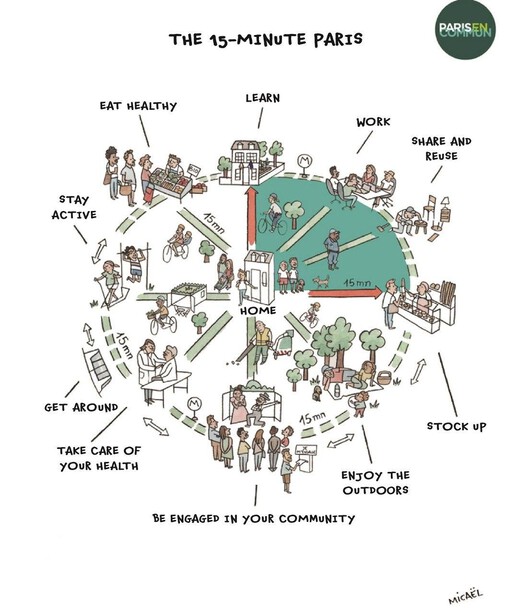How do relatively straightforward ideas become so controversial?
The 15-minute city (FMC or 15mC) is an urban planning concept that aims to make cities or towns more liveable by ensuring that all essential services — think schools, medical care and shops — are within the distance of a short walk or bicycle ride.

If you have visited places like Amsterdam or Paris, that have both borrowed from FMC principles, you’ve probably thought ‘this seems like a pretty nice way of living’.
Not so in Oxford, UK. A rally attend by thousands in February claimed to be protesting plans to reconfigure the city as a “Stalinist-style, closed city” that could lead to the eventual enslavement of local citizens. Similar plans in Bath, where residents could be divided into ‘cells’ that limit travel, have been compared to The Hunger Games.
Speaking in the House of Commons Tory MP Nick Fletcher, demanded a debate on the “international socialist concept of so-called 15-minute cities”, and said that the schemes could “take away our personal freedom”.
I’m a declared fan of the concept of 15 minute cities, but equally I don’t think we can dismiss all criticism as the work of right wing conspiracy theorists. So what’s the problem?
Alain Bertaud is an urban planner and author who has been critical of the concept of 15-minute cities. Bertaud argues that the idea is too idealistic and impractical.
Bertaud has pointed out that cities are complex systems with many different types of land uses and activities, and it is not feasible to organise everything within a 15-minute radius. He argues that cities should be more flexible and adaptable to change, and that they should be designed to allow for the efficient movement of people and goods.
His more interesting point is that the focus on the 15-minute city is misplaced because it does not address the underlying issues that create urban problems, such as poverty, inequality, and environmental degradation. He suggests that policymakers and urban planners should focus on creating affordable and accessible housing, improving public transportation, and promoting economic development in areas that are currently underserved.
So: the state and institutions should focus on what they should be doing anyway, and leave communities to do the rest.
In his book Order Without Design, Bertaud notes that most Parisians have already achieved access to a wide number of grocery stores, bakeries, and the like within walking distance without the help of planners.
“The abundance and variety of bakeries are not due to meticulous municipal planning but to market mechanisms,” he writes. “If Parisians were to prefer herring to croissants for breakfast in the future, the market would adjust, and herring merchants will gradually replace the bakeries without any ‘redesign’ of Paris.”
Writing in The Telegraph, Neil Garratt builds on this theme: “planning cities is like herding cats: people have their own ideas. They go where they will, make their own plans, and real-life cities emerge from all those individual decisions.”
The Planners vs The People
The objection to 15 minute cities has possibly been stoked by over-reach from local authorities. Surely no-one objects to the idea that we shouldn’t be building new housing where people have to drive to buy a pint of milk, go to school or visit the doctor because there’s no shops, schools or surgeries close by?
However, in the Oxford case it appears that authorities plan to go a lot further than that. Traffic filters would be in place designed to reduce traffic, make bus journeys faster and make walking and cycling safer. The scheme will be enforced using automatic number plate recognition cameras. Residents in Oxford and some areas just outside the city will be able to apply for a permit to drive through the traffic filters for up to 100 days per year.
It’s measures like limiting people to car travel 100 days per year that could appear top down and authoritarian and seem to be fuelling the resistance.
Let’s compare the Oxford approach with the small northern Dutch village of Makkinga which is entirely free of traffic signs or rules. People living there have to find their own way around, negotiate for themselves, and use their own brains.
It’s part of a movement started by the late traffic engineer Hans Monderman of “designing for negotiation” where everyday citizens are given agency and can co-design their own rules. Monderman once responded to a question as to why he didn’t see traffic signs as a way to change behaviour: “I don’t want traffic behaviour, I want social behaviour.”
Oxford, it seems, are designing for traffic behaviour not social behaviour. They want a system that is unambiguous. But ambiguity has a lot going for it.
As Mark McArthur Christie has said, when you introduce ambiguity, rather than control, into a system, people think for themselves and find a way to reach the right answer.
So, 15 Minute Cities aren’t a bad idea in and of themselves if we allow the citizen to play an active part in the design of them.
Sometimes good ideas turn into bad ones because of the implementation rather than the intent.


